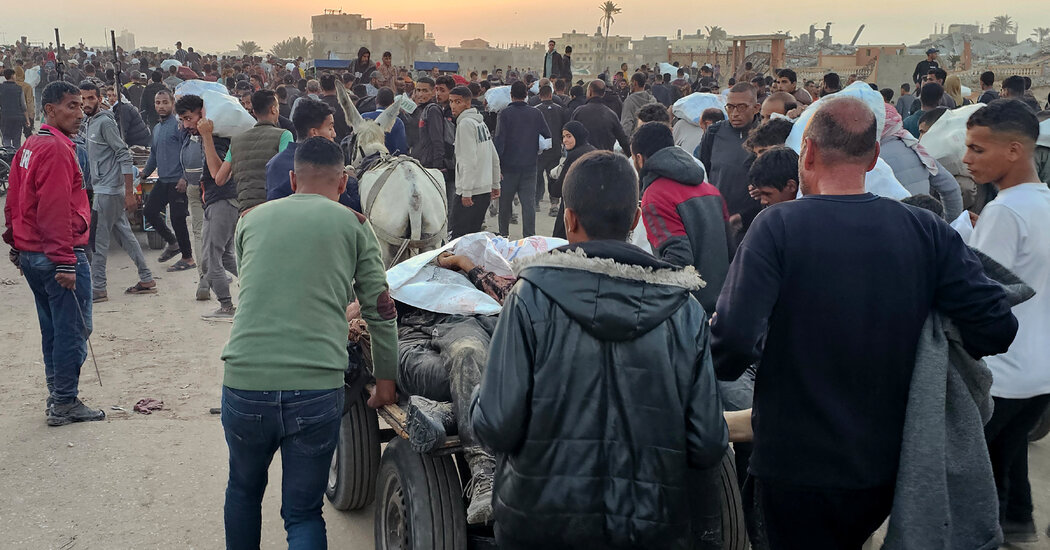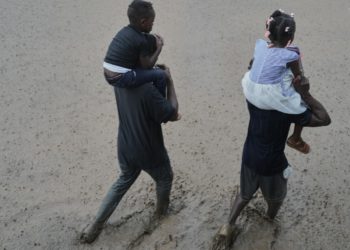More than 20 people were killed on Sunday and more than 100 wounded when Palestinians who had gathered overnight in the hope of obtaining food from an aid distribution center in Gaza came under fire, according to local health officials.
The incident was the latest episode to ensnarl the Israeli-backed initiative to establish aid distribution sites run by American security contractors in the enclave. The Israeli military initially said it was unaware of any injuries from Israeli fire at the site, but a military official later briefed reporters that troops had fired warning shots toward “suspects” who approached them about a kilometer away.
Palestinian paramedics evacuated the bodies of at least 23 people from the vicinity of the distribution center in the southern Gazan city of Rafah, according to the Palestine Red Crescent Society. The International Committee of the Red Cross said its field hospital in Rafah had received 179 cases, the majority with gunshot or shrapnel wounds, and said 21 people had been declared dead on arrival. Gaza’s health ministry said 31 had been killed.
“All patients said they had been trying to reach an aid distribution site. This is the highest number of weapon-wounded in a single incident since the establishment of the field hospital over a year ago,” the Red Cross said in a statement.
Speaking on condition of anonymity to comply with military protocol, the military official said soldiers had acted to prevent several people from approaching the troops when the aid point was not operating, including with “warning shots.”
Israeli officials had said the new system of four sites in southern Gaza would prevent Hamas from seizing the food, fuel and other goods, but aid agencies have criticized the initiative.
Huge crowds of Gazans have headed for the new aid sites, to try and obtain a box of food since the program started last week. While some days have gone relatively smoothly, there have also been chaotic scenes, including one instance in which Israeli forces fired what they described as warning shots.
The United Nations and other major humanitarian relief groups have boycotted the operation, and accused Israel of wielding aid as part of its military strategy. U.N. officials said there was little evidence that Hamas systematically diverted relief. Critics in Israel have warned the effort could be the first step toward establishing formal Israeli rule over Gaza.
Israeli military officials and some of their business associates drew up plans for the new aid program, which stipulates that Israeli forces secure the perimeter of the sites. U.S. security contractors are overseeing the distribution of boxes of food as part of the newly created Gaza Humanitarian Foundation.
For Palestinians facing widespread hunger after Israel blocked food from entering Gaza two months ago, the procedures for getting the aid have often been unclear. Many have sought to beat the massive crowds flooding the aid sites by arriving as early as possible, often walking long distances, in an attempt to get a prized carton of basic staples.
Abdulrahman Odeh, 21, described walking in a big crowd before dawn on Sunday to try to reach the distribution site in Rafah’s Tel al-Sultan neighborhood. He said he saw Israeli forces, including a tank and a military jeep, along the roughly three-mile route.
At approximately 4:30 a.m., before he had reached the distribution point, the shooting started, said Mr. Odeh.
A second witness, who spoke anonymously for fear of retribution from Israel or Hamas, described a massive burst of gunfire at around the same time, forcing him to drop to the ground. He said he ultimately fled home empty-handed.
Mr. Odeh said he saw several bodies carted away after the shooting, but was able to eventually reach the distribution site and obtain a carton of aid. “There’s no system or order to receive it,” he said. “It’s survival of the fittest.”
On Sunday, the Gaza Humanitarian Foundation said that it was unaware of any attacks in or around its distribution sites and that the aid was distributed between 5 a.m. and 6 a.m. “Our aid was again distributed today without incident,” it said.
Cindy McCain, executive director of the United Nations’ World Food Program, disputed the Gaza Humanitarian Foundation’s assessment. Appearing on ABC’s “This Week with George Stephanopoulos,” Ms. McCain said her organization’s personnel in Gaza were similarly reporting that people had been killed on Sunday morning.
She added that aid agencies need “unfettered access,” to feed people and the World Food Program had not seen any plan from the Gaza Humanitarian Foundation.
The violence took place a day after the Trump administration rejected Hamas’s response to its latest cease-fire proposal. Israel and Hamas have held numerous rounds of indirect cease-fire talks that have foundered over terms for ending the war, brokered by the likes of Qatar and Egypt.
Benjamin Netanyahu, the Israeli prime minister, has said he is ready for a temporary truce. But he has refused to end the war unless Hamas puts down its weapons and sends its leaders into exile. The Palestinian group has repeatedly rejected those demands.
On Saturday, the United States suggested a two-month truce in return for the freeing by Hamas of some of the hostages seized in the Hamas-led attack on Israel on Oct. 7, 2023. Hamas officials argued that the proposal did not go far enough to ensure that cease-fire would lead to an end to the war — an issue that has remained a key sticking point over the past few months — and said it had made suggestions to achieve a permanent resolution.
Steve Witkoff, President Trump’s Mideast envoy, called Hamas’s counteroffer “totally unacceptable,” saying it “only takes us backward.”
Both Israel and Hamas have faced rising pressure to reach a compromise, however. Israel has faced increasing international anger, including from its allies, over the widespread hunger and deprivation in Gaza. Palestinians in Gaza have held rare protests against Hamas, calling for the group to end the war and leave the enclave which it has ruled since 2007.
For more than two months, the Israeli authorities imposed a near-total blockade on Gaza, stopping shipments of food, fuel and medicine from entering the enclave in what they called an attempt to pressure Hamas over stalled cease-fire talks.
Since the restrictions were imposed, many Gazans have gone hungry as stockpiles of food dwindled and aid agencies warned that Gazans were on the brink of famine. Communal soup kitchens closed and doctors have reported increasing amounts of malnutrition, including among children. Israel began relaxing the ban on humanitarian aid in mid-May.
On Tuesday, the first full day of operation for the new aid program, chaos erupted at one of the distribution sites in Rafah’s Tel al-Sultan neighborhood. Large groups of Palestinians who were forced to crowd into small, fenced-in corridors burst through barriers into the area.
The Israeli military said soldiers fired “warning shots in the area outside the compound” in an effort to restore control. The Gaza Humanitarian Foundation denied any “civilians or individuals involved with the distribution of aid” were harmed in the incident.
The Red Cross later reported that its nearby field hospital had received about 48 people, including women and children, suffering from gunshot wounds on Tuesday night. The organization did not say whether the two incidents were connected.
Reporting was contributed by Gabby Sobelmanin Rehovot, Israel, Rawan Sheikh Ahmadin Haifa, Israel, Iyad Abuheweila in Istanbul, Turkey, Myra Noveckin Jerusalem, and Steven Moityin Washington, D.C.
Aaron Boxerman is a Times reporter covering Israel and Gaza. He is based in Jerusalem.
The post More Than 20 Killed Near Aid Distribution Site in Gaza, Health Officials Say appeared first on New York Times.




